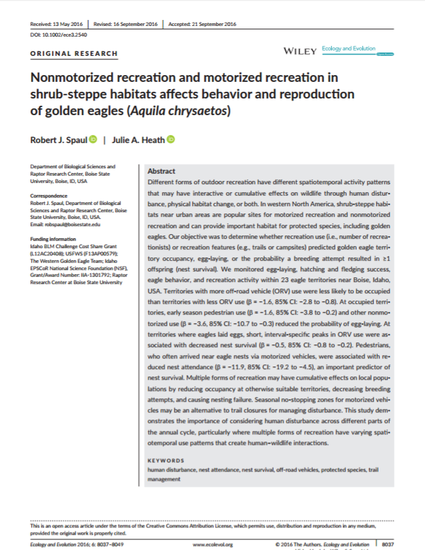
Different forms of outdoor recreation have different spatiotemporal activity patterns that may have interactive or cumulative effects on wildlife through human disturbance, physical habitat change, or both. In western North America, shrub-steppe habitats near urban areas are popular sites for motorized recreation and nonmotorized recreation and can provide important habitat for protected species, including golden eagles. Our objective was to determine whether recreation use (i.e., number of recreationists) or recreation features (e.g., trails or campsites) predicted golden eagle territory occupancy, egg-laying, or the probability a breeding attempt resulted in ≥1 offspring (nest survival). We monitored egg-laying, hatching and fledging success, eagle behavior, and recreation activity within 23 eagle territories near Boise, Idaho, USA. Territories with more off-road vehicle (ORV) use were less likely to be occupied than territories with less ORV use (β = −1.6, 85% CI: −2.8 to −0.8). At occupied territories, early season pedestrian use (β = −1.6, 85% CI: −3.8 to −0.2) and other nonmotorized use (β = −3.6, 85% CI: −10.7 to −0.3) reduced the probability of egg-laying. At territories where eagles laid eggs, short, interval-specific peaks in ORV use were associated with decreased nest survival (β = −0.5, 85% CI: −0.8 to −0.2). Pedestrians, who often arrived near eagle nests via motorized vehicles, were associated with reduced nest attendance (β = −11.9, 85% CI: −19.2 to −4.5), an important predictor of nest survival. Multiple forms of recreation may have cumulative effects on local populations by reducing occupancy at otherwise suitable territories, decreasing breeding attempts, and causing nesting failure. Seasonal no-stopping zones for motorized vehicles may be an alternative to trail closures for managing disturbance. This study demonstrates the importance of considering human disturbance across different parts of the annual cycle, particularly where multiple forms of recreation have varying spatiotemporal use patterns that create human–wildlife interactions.
This document was originally published in Ecology and Evolution by Wiley. This work is provided under a Creative Commons Attribution 4.0 license. Details regarding the use of this work can be found at: http://creativecommons.org/licenses/by/4.0/. doi: 10.1002/ece3.2540
Available at: http://works.bepress.com/julie_heath/44/
